初中英语选词填空解题技巧资料
- 格式:doc
- 大小:41.50 KB
- 文档页数:5
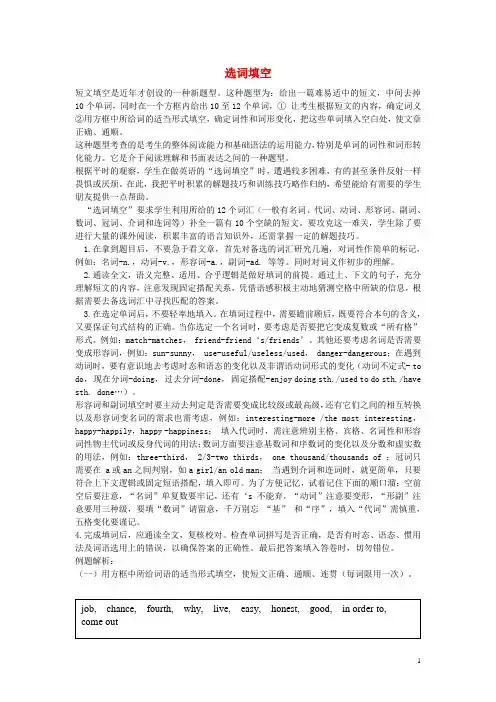
选词填空短文填空是近年才创设的一种新题型。
这种题型为:给出一篇难易适中的短文,中间去掉10个单词,同时在一个方框内给出10至12个单词,①让考生根据短文的内容,确定词义②用方框中所给词的适当形式填空,确定词性和词形变化,把这些单词填入空白处,使文章正确、通顺。
这种题型考查的是考生的整体阅读能力和基础语法的运用能力,特别是单词的词性和词形转化能力。
它是介于阅读理解和书面表达之间的一种题型。
根据平时的观察,学生在做英语的“选词填空”时,遭遇较多困难,有的甚至条件反射一样畏惧或厌烦。
在此,我把平时积累的解题技巧和训练技巧略作归纳,希望能给有需要的学生朋友提供一点帮助。
“选词填空”要求学生利用所给的12个词汇(一般有名词、代词、动词、形容词、副词、数词、冠词、介词和连词等)补全一篇有10个空缺的短文。
要攻克这一难关,学生除了要进行大量的课外阅读,积累丰富的语言知识外,还需掌握一定的解题技巧。
1.在拿到题目后,不要急于看文章,首先对备选的词汇研究几遍,对词性作简单的标记,例如:名词-n.,动词-v.,形容词-a.,副词-ad. 等等。
同时对词义作初步的理解。
2.通读全文,语义完整、适用、合乎逻辑是做好填词的前提。
通过上、下文的句子,充分理解短文的内容,注意发现固定搭配关系,凭借语感积极主动地猜测空格中所缺的信息,根据需要去备选词汇中寻找匹配的答案。
3.在选定单词后,不要轻率地填入。
在填词过程中,需要瞻前顾后,既要符合本句的含义,又要保证句式结构的正确。
当你选定一个名词时,要考虑是否要把它变成复数或“所有格”形式。
例如:match-matches, friend-friend‘s/friends’。
其他还要考虑名词是否需要变成形容词,例如:sun-sunny, use-useful/useless/used, danger-dangerous;在遇到动词时,要有意识地去考虑时态和语态的变化以及非谓语动词形式的变化(动词不定式- to do,现在分词-doing,过去分词-done,固定搭配-enjoy doing sth./used to do sth./have sth. done…)。
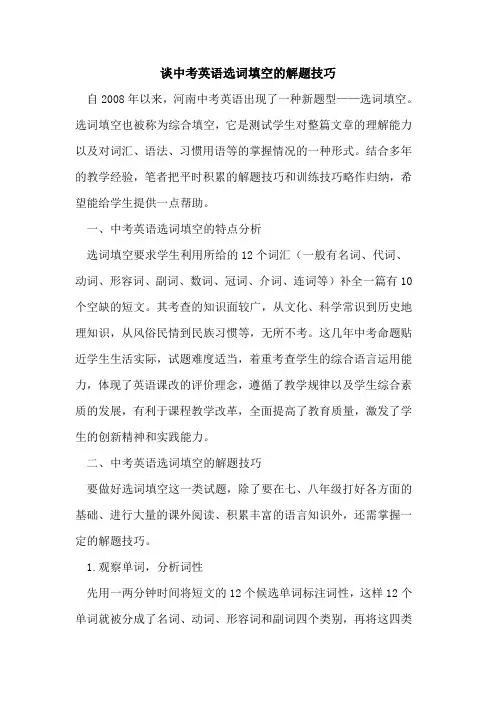
谈中考英语选词填空的解题技巧自2008年以来,河南中考英语出现了一种新题型——选词填空。
选词填空也被称为综合填空,它是测试学生对整篇文章的理解能力以及对词汇、语法、习惯用语等的掌握情况的一种形式。
结合多年的教学经验,笔者把平时积累的解题技巧和训练技巧略作归纳,希望能给学生提供一点帮助。
一、中考英语选词填空的特点分析选词填空要求学生利用所给的12个词汇(一般有名词、代词、动词、形容词、副词、数词、冠词、介词、连词等)补全一篇有10个空缺的短文。
其考查的知识面较广,从文化、科学常识到历史地理知识,从风俗民情到民族习惯等,无所不考。
这几年中考命题贴近学生生活实际,试题难度适当,着重考查学生的综合语言运用能力,体现了英语课改的评价理念,遵循了教学规律以及学生综合素质的发展,有利于课程教学改革,全面提高了教育质量,激发了学生的创新精神和实践能力。
二、中考英语选词填空的解题技巧要做好选词填空这一类试题,除了要在七、八年级打好各方面的基础、进行大量的课外阅读、积累丰富的语言知识外,还需掌握一定的解题技巧。
1.观察单词,分析词性先用一两分钟时间将短文的12个候选单词标注词性,这样12个单词就被分成了名词、动词、形容词和副词四个类别,再将这四类单词细化到n.1,n.2,n.3,v.1,v.2,v.3,adj.1,adj.2,adv.1,adv.2等因为这四类词通常是需要根据整篇语境进行适当形式填空的。
如果所确定的词是名词、动词、形容词、副词,应该考虑这些词的相应的形式。
当然,其余不需要变换形式的单词,如介词、连词等也要观察一下它们的特征,比如with和without,although和but,because和so同时出现时,只选其中之一即可,这样就大大降低了选词的难度。
2.快速浏览全文在开始选词填空之前,浏览一下文章,了解一下文章大意是必要的,尤其是要仔细看文章的第一句和各段的首句。
这是因为西方人写文章惯用演绎法,喜欢先把自己要说的意思用一句话概括出来,然后再铺陈论证。
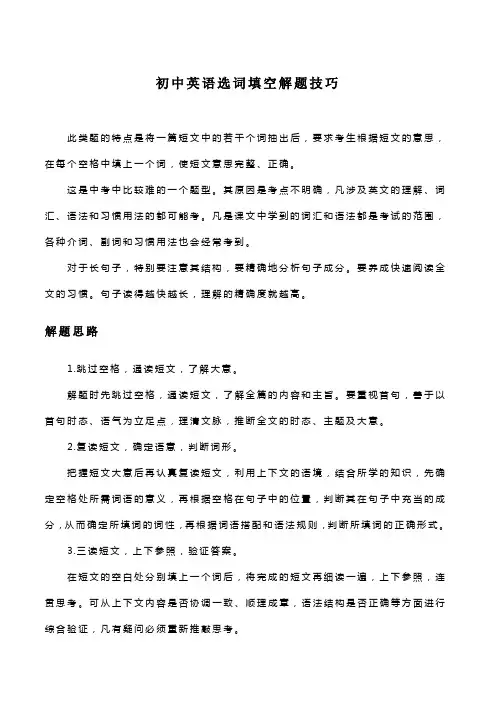
初中英语选词填空解题技巧此类题的特点是将一篇短文中的若干个词抽出后,要求考生根据短文的意思,在每个空格中填上一个词,使短文意思完整、正确。
这是中考中比较难的一个题型。
其原因是考点不明确,凡涉及英文的理解、词汇、语法和习惯用法的都可能考。
凡是课文中学到的词汇和语法都是考试的范围,各种介词、副词和习惯用法也会经常考到。
对于长句子,特别要注意其结构,要精确地分析句子成分。
要养成快速阅读全文的习惯。
句子读得越快越长,理解的精确度就越高。
解题思路1.跳过空格,通读短文,了解大意。
解题时先跳过空格,通读短文,了解全篇的内容和主旨。
要重视首句,善于以首句时态、语气为立足点,理清文脉,推断全文的时态、主题及大意。
2.复读短文,确定语意,判断词形。
把握短文大意后再认真复读短文,利用上下文的语境,结合所学的知识,先确定空格处所需词语的意义,再根据空格在句子中的位置,判断其在句子中充当的成分,从而确定所填词的词性,再根据词语搭配和语法规则,判断所填词的正确形式。
3.三读短文,上下参照,验证答案。
在短文的空白处分别填上一个词后,将完成的短文再细读一遍,上下参照,连贯思考。
可从上下文内容是否协调一致、顺理成章,语法结构是否正确等方面进行综合验证,凡有疑问必须重新推敲思考。
注意!1.语意完整、适用是做好填词的前提,要从全文的内容出发,前后文联系起来考虑。
2.要善于从文中同样结构或类似结构中寻找线索,从中得到提示和启发,帮助确定应填词的词性和词形,这样可避免想当然地随意乱填。
3.填词时应注意词形,不可简单地都填词的原形。
若空格内填的是名词,要考虑其单复数形式;若填的是形容词或副词,要考虑其是否用比较级或最高级;若填的是动词,要特别注意考虑其时态和语态;如在句首,还要考虑其首字母要大写。
4.有些空格需要填入介词、连词等,除考虑上下文的内容外,还要考虑和其他词的固定搭配及习惯用法。
中考真题(河南中考)阅读短文,从方框中选择适当的词并用其正确形式填空,使短文意思通顺、完整。
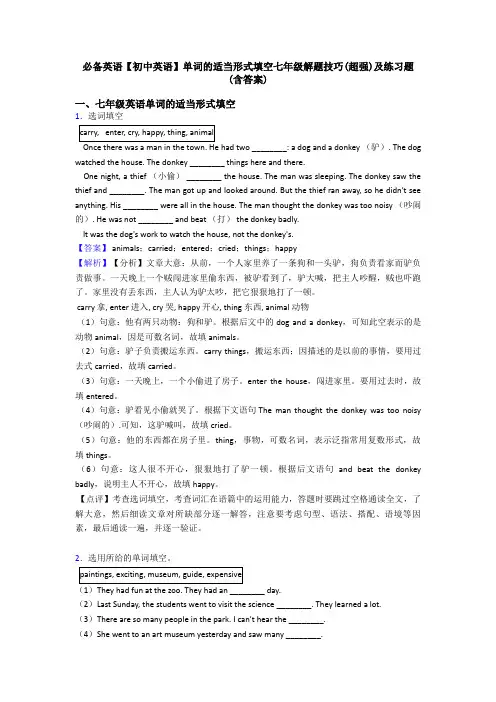
必备英语【初中英语】单词的适当形式填空七年级解题技巧(超强)及练习题(含答案)一、七年级英语单词的适当形式填空1.选词填空(驴). The dog watched the house. The donkey ________ things here and there.One night, a thief (小偷) ________ the house. The man was sleeping. The donkey saw the thief and ________. The man got up and looked around. But the thief ran away, so he didn't see anything. His ________ were all in the house. The man thought the donkey was too noisy (吵闹的). He was not ________ and beat (打) the donkey badly.It was the dog's work to watch the house, not the donkey's.【答案】 animals;carried;entered;cried;things;happy【解析】【分析】文章大意:从前,一个人家里养了一条狗和一头驴,狗负责看家而驴负责做事。
一天晚上一个贼闯进家里偷东西,被驴看到了,驴大喊,把主人吵醒,贼也吓跑了。
家里没有丢东西,主人认为驴太吵,把它狠狠地打了一顿。
carry 拿, enter 进入, cry 哭, happy 开心, thing 东西, animal 动物(1)句意:他有两只动物:狗和驴。
根据后文中的dog and a donkey,可知此空表示的是动物animal,因是可数名词,故填animals。

(完整)初中英语选词填空解题技巧及练习题(word版可编辑修改)编辑整理:尊敬的读者朋友们:这里是精品文档编辑中心,本文档内容是由我和我的同事精心编辑整理后发布的,发布之前我们对文中内容进行仔细校对,但是难免会有疏漏的地方,但是任然希望((完整)初中英语选词填空解题技巧及练习题(word版可编辑修改))的内容能够给您的工作和学习带来便利。
同时也真诚的希望收到您的建议和反馈,这将是我们进步的源泉,前进的动力。
本文可编辑可修改,如果觉得对您有帮助请收藏以便随时查阅,最后祝您生活愉快业绩进步,以下为(完整)初中英语选词填空解题技巧及练习题(word版可编辑修改)的全部内容。
中考英语选词填空解题技巧“选词填空”要求学生利用所给的12个词汇(一般有名词、代词、动词、形容词、副词、数词、冠词、介词和连词等)补全一篇有10个空缺的短文。
要攻克这一难关,学生除了要进行大量的课外阅读,积累丰富的语言知识外,还需掌握一定的解题技巧.1.-n.,动词—v。
,形容词-a.,副词—ad。
等等。
同时对词义作初步的理解。
2.通读全文,语义完整、适用、合乎逻辑是做好填词的前提。
通过上、下文的句子,中所缺的信息,根据需要去备选词汇中寻找匹配的答案。
3..例如:match-matches,friendsun—sunny, use—useful/useless/used, danger-dangerous;(动词不定式- to do, 现在分词—doing,过去分词-done, 固定搭配—enjoy doing sth。
/used to do sth。
/have sth. done…);:interesting—more /the most interesting, happy—happily,happy -happiness;★对于数词,要注意基数词和序数词的变化以及分数和虚实数的用法,例如:three—third, 2/3—two thirds, one thousand/thousands of ;★对于冠词,只需要在 a或an之间判别,如a girl /an old man;★对于介词和连词时,就更简单,只要符合上下文逻辑或固定短语搭配,填入即可。
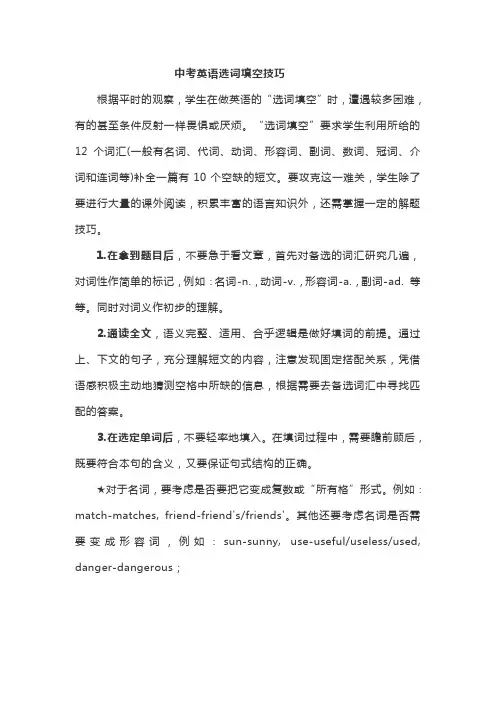
中考英语选词填空技巧根据平时的观察,学生在做英语的“选词填空”时,遭遇较多困难,有的甚至条件反射一样畏惧或厌烦。
“选词填空”要求学生利用所给的12个词汇(一般有名词、代词、动词、形容词、副词、数词、冠词、介词和连词等)补全一篇有10个空缺的短文。
要攻克这一难关,学生除了要进行大量的课外阅读,积累丰富的语言知识外,还需掌握一定的解题技巧。
1.在拿到题目后,不要急于看文章,首先对备选的词汇研究几遍,对词性作简单的标记,例如:名词-n.,动词-v.,形容词-a.,副词-ad. 等等。
同时对词义作初步的理解。
2.通读全文,语义完整、适用、合乎逻辑是做好填词的前提。
通过上、下文的句子,充分理解短文的内容,注意发现固定搭配关系,凭借语感积极主动地猜测空格中所缺的信息,根据需要去备选词汇中寻找匹配的答案。
3.在选定单词后,不要轻率地填入。
在填词过程中,需要瞻前顾后,既要符合本句的含义,又要保证句式结构的正确。
★对于名词,要考虑是否要把它变成复数或“所有格”形式。
例如:match-matches, friend-friend's/friends'。
其他还要考虑名词是否需要变成形容词,例如:sun-sunny, use-useful/useless/used, danger-dangerous;★对于动词,要有意识地去考虑时态和语态的变化以及非谓语动词形式的变化(动词不定式- to do, 现在分词-doing, 过去分词-done, 固定搭配-enjoy doing sth./used to do sth./have sth. done…);★对于形容词和副词,要主动去判定它们之间的相互转换,是否需要变成比较级或最高级,还有以及形容词变名词的需求也需考虑,例如:interesting-more /the most interesting, happy-happily,happy -happiness;★对于代词,注意辨别主格、宾格、名词性和形容词性物主代词或反身代词的用法;★对于数词,要注意基数词和序数词的变化以及分数和虚实数的用法,例如:three-third, 2/3-two thirds, one thousand/thousands of ;★对于冠词,只需要在a或an之间判别,如a girl /an old man;★对于介词和连词时,就更简单,只要符合上下文逻辑或固定短语搭配,填入即可。
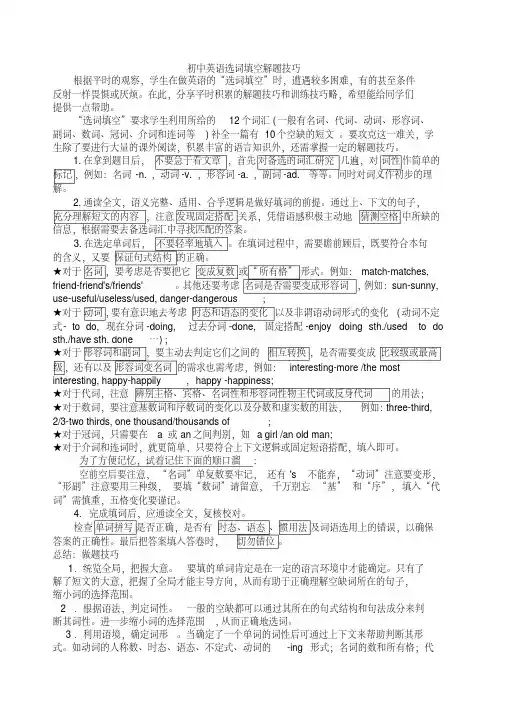
初中英语选词填空解题技巧根据平时的观察,学生在做英语的“选词填空”时,遭遇较多困难,有的甚至条件反射一样畏惧或厌烦。
在此,分享平时积累的解题技巧和训练技巧略,希望能给同学们提供一点帮助。
“选词填空”要求学生利用所给的12个词汇(一般有名词、代词、动词、形容词、副词、数词、冠词、介词和连词等)补全一篇有10个空缺的短文。
要攻克这一难关,学生除了要进行大量的课外阅读,积累丰富的语言知识外,还需掌握一定的解题技巧。
1.在拿到题目后,不要急于看文章,首先对备选的词汇研究几遍,对词性作简单的标记,例如:名词-n.,动词-v.,形容词-a.,副词-ad. 等等。
同时对词义作初步的理解。
2.通读全文,语义完整、适用、合乎逻辑是做好填词的前提。
通过上、下文的句子,充分理解短文的内容,注意发现固定搭配关系,凭借语感积极主动地猜测空格中所缺的信息,根据需要去备选词汇中寻找匹配的答案。
3.在选定单词后,不要轻率地填入。
在填词过程中,需要瞻前顾后,既要符合本句的含义,又要保证句式结构的正确。
★对于名词,要考虑是否要把它变成复数或“所有格”形式。
例如:match-matches, friend-friend's/friends'。
其他还要考虑名词是否需要变成形容词,例如:sun-sunny, use-useful/useless/used, danger-dangerous;★对于动词,要有意识地去考虑时态和语态的变化以及非谓语动词形式的变化(动词不定式- to do, 现在分词-doing, 过去分词-done, 固定搭配-enjoy doing sth./used to do sth./have sth. done…);★对于形容词和副词,要主动去判定它们之间的相互转换,是否需要变成比较级或最高级,还有以及形容词变名词的需求也需考虑,例如:interesting-more /the most interesting, happy-happily,happy -happiness;★对于代词,注意辨别主格、宾格、名词性和形容词性物主代词或反身代词的用法;★对于数词,要注意基数词和序数词的变化以及分数和虚实数的用法,例如:three-third,2/3-two thirds, one thousand/thousands of ;★对于冠词,只需要在 a或an之间判别,如 a girl /an old man;★对于介词和连词时,就更简单,只要符合上下文逻辑或固定短语搭配,填入即可。
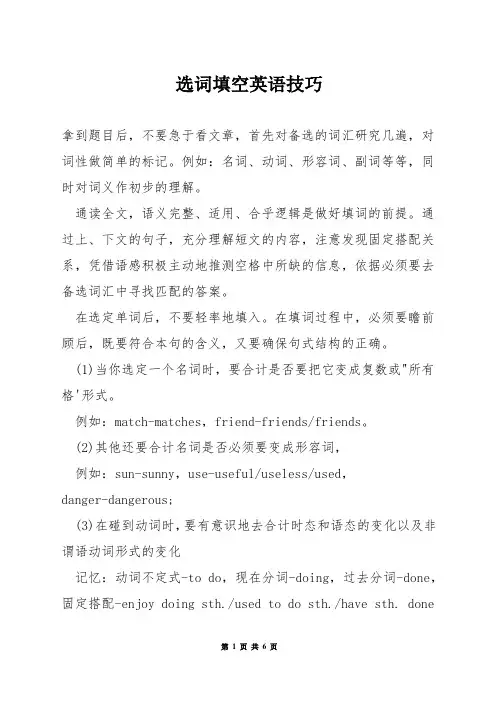
选词填空英语技巧拿到题目后,不要急于看文章,首先对备选的词汇研究几遍,对词性做简单的标记。
例如:名词、动词、形容词、副词等等,同时对词义作初步的理解。
通读全文,语义完整、适用、合乎逻辑是做好填词的前提。
通过上、下文的句子,充分理解短文的内容,注意发现固定搭配关系,凭借语感积极主动地推测空格中所缺的信息,依据必须要去备选词汇中寻找匹配的答案。
在选定单词后,不要轻率地填入。
在填词过程中,必须要瞻前顾后,既要符合本句的含义,又要确保句式结构的正确。
(1)当你选定一个名词时,要合计是否要把它变成复数或"所有格'形式。
例如:match-matches,friend-friends/friends。
(2)其他还要合计名词是否必须要变成形容词,例如:sun-sunny,use-useful/useless/used,danger-dangerous;(3)在碰到动词时,要有意识地去合计时态和语态的变化以及非谓语动词形式的变化记忆:动词不定式-to do,现在分词-doing,过去分词-done,固定搭配-enjoy doing sth./used to do sth./have sth. done完成填词后,应通读全文,复核校对。
检查单词拼写是否正确,是否有时态、语态、惯用法及词语选用上的错误,以保证答案的正确性。
最后把答案填入答卷,切勿错位。
2英语选词填空攻略筛选单词。
通过多年的教学我们发现,抛开文章本身不管,选词填空的15个备选单词往往就是给大家造成的第一个障碍。
实际上最行之有效的办法就是从中挑选出大家最熟悉的假设干单词进行选择,而将陌生词汇排除在合计范围之外。
实际上,15个单词当中真正能成为答案的也只有10个,而这10个当中又有绝大多数的都属于基本词汇的范畴。
所以与其冥思苦想执着于假设干难词、长词,还不如把注意力集中到自己熟悉的简单词上来,重点突破,效率更高。
词性分类。
挑选出熟悉单词之后我们无妨依据词性将这些单词分门别类,便于待会逐一对应。
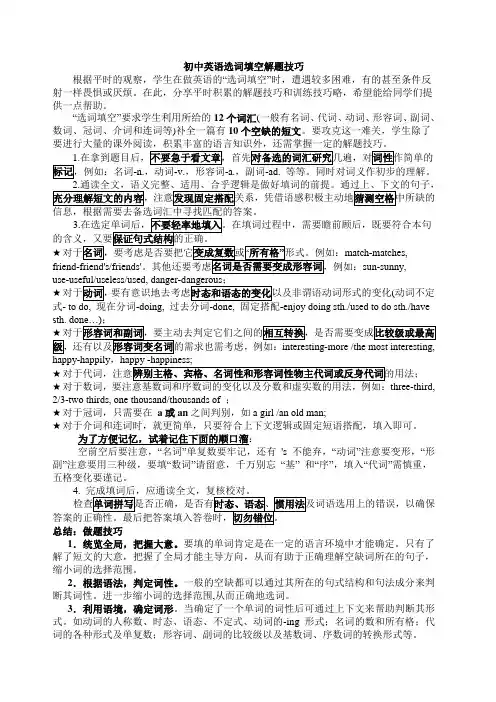
初中英语选词填空解题技巧 根据平时的观察,学生在做英语的“选词填空”时,遭遇较多困难,有的甚至条件反射一样畏惧或厌烦。在此,分享平时积累的解题技巧和训练技巧略,希望能给同学们提供一点帮助。 “选词填空”要求学生利用所给的12个词汇(一般有名词、代词、动词、形容词、副词、数词、冠词、介词和连词等)补全一篇有10个空缺的短文。要攻克这一难关,学生除了要进行大量的课外阅读,积累丰富的语言知识外,还需掌握一定的解题技巧。 1.在拿到题目后,不要急于看文章,首先对备选的词汇研究几遍,对词性作简单的标记,例如:名词-n.,动词-v.,形容词-a.,副词-ad. 等等。同时对词义作初步的理解。 2.通读全文,语义完整、适用、合乎逻辑是做好填词的前提。通过上、下文的句子,充分理解短文的内容,注意发现固定搭配关系,凭借语感积极主动地猜测空格中所缺的信息,根据需要去备选词汇中寻找匹配的答案。 3.在选定单词后,不要轻率地填入。在填词过程中,需要瞻前顾后,既要符合本句的含义,又要保证句式结构的正确。 ★对于名词,要考虑是否要把它变成复数或“所有格”形式。例如:match-matches, friend-friend's/friends'。其他还要考虑名词是否需要变成形容词,例如:sun-sunny, use-useful/useless/used, danger-dangerous; ★对于动词,要有意识地去考虑时态和语态的变化以及非谓语动词形式的变化(动词不定式- to do, 现在分词-doing, 过去分词-done, 固定搭配-enjoy doing sth./used to do sth./have sth. done…); ★对于形容词和副词,要主动去判定它们之间的相互转换,是否需要变成比较级或最高级,还有以及形容词变名词的需求也需考虑,例如:interesting-more /the most interesting, happy-happily,happy -happiness; ★对于代词,注意辨别主格、宾格、名词性和形容词性物主代词或反身代词的用法; ★对于数词,要注意基数词和序数词的变化以及分数和虚实数的用法,例如:three-third, 2/3-two thirds, one thousand/thousands of ; ★对于冠词,只需要在 a或an之间判别,如a girl /an old man; ★对于介词和连词时,就更简单,只要符合上下文逻辑或固定短语搭配,填入即可。 为了方便记忆,试着记住下面的顺口溜: 空前空后要注意,“名词”单复数要牢记,还有 's 不能弃,“动词”注意要变形,“形副”注意要用三种级,要填“数词”请留意,千万别忘 “基” 和“序”,填入“代词”需慎重,五格变化要谨记。 4. 完成填词后,应通读全文,复核校对。 检查单词拼写是否正确,是否有时态、语态、惯用法及词语选用上的错误,以确保答案的正确性。最后把答案填入答卷时,切勿错位。 总结:做题技巧 1.统览全局,把握大意。要填的单词肯定是在一定的语言环境中才能确定。只有了解了短文的大意,把握了全局才能主导方向,从而有助于正确理解空缺词所在的句子,缩小词的选择范围。 2.根据语法,判定词性。一般的空缺都可以通过其所在的句式结构和句法成分来判断其词性。进一步缩小词的选择范围,从而正确地选词。 3.利用语境,确定词形。当确定了一个单词的词性后可通过上下文来帮助判断其形式。如动词的人称数、时态、语态、不定式、动词的-ing形式;名词的数和所有格;代词的各种形式及单复数;形容词、副词的比较级以及基数词、序数词的转换形式等。 4.复读全文,验正答案。填完单词后,不可孤立地逐个检查词,而必须将所有填入的词代入文章中,复读全文,仔细检查所填词是否符合文章的情景内容,读起来是否流畅,是否合乎句法,单词拼写是否有误,单词形式是否正确等。发现问题及时更正。通过再读全文,很可能利用语感将个别特别难的空处顺口“读”出来。 例题:(2010年河南省中招选词填空题节选) 阅读短文,从方框中选择适当的词并用其正确形式填空,使短文通顺、意思完整。请将答写在短文后相应题号的横线上。每空限填一词,每词限用一次。方框中有两个词是多余的。 dirty with have always time they large want speak lesson first drop
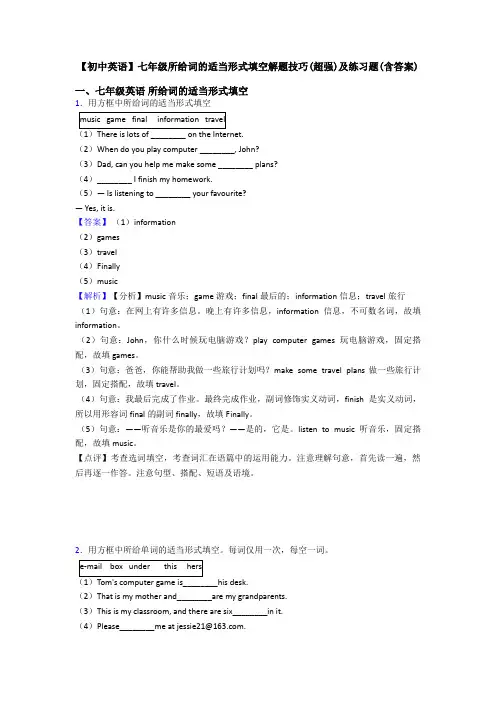
【初中英语】七年级所给词的适当形式填空解题技巧(超强)及练习题(含答案) 一、七年级英语 所给词的适当形式填空 1.用方框中所给词的适当形式填空
music game final information travel (1)There is lots of ________ on the Internet. (2)When do you play computer ________, John? (3)Dad, can you help me make some ________ plans? (4)________ I finish my homework. (5)— Is listening to ________ your favourite? — Yes, it is. 【答案】 (1)information (2)games (3)travel (4)Finally (5)music 【解析】【分析】music音乐;game游戏;final最后的;information信息;travel旅行 (1)句意:在网上有许多信息。晚上有许多信息,information信息,不可数名词,故填information。 (2)句意:John,你什么时候玩电脑游戏?play computer games玩电脑游戏,固定搭配,故填games。 (3)句意:爸爸,你能帮助我做一些旅行计划吗?make some travel plans做一些旅行计划,固定搭配,故填travel。 (4)句意:我最后完成了作业。最终完成作业,副词修饰实义动词,finish是实义动词,所以用形容词final的副词finally,故填Finally。 (5)句意:——听音乐是你的最爱吗?——是的,它是。listen to music听音乐,固定搭配,故填music。 【点评】考查选词填空,考查词汇在语篇中的运用能力。注意理解句意,首先读一遍,然后再逐一作答。注意句型、搭配、短语及语境。
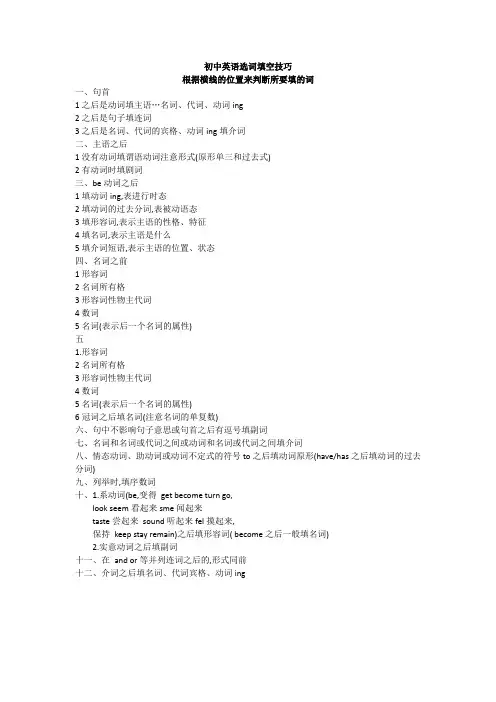
初中英语选词填空技巧
根据横线的位置来判断所要填的词
一、句首
1之后是动词填主语…名词、代词、动词ing
2之后是句子填连词
3之后是名词、代词的宾格、动词ing填介词
二、主语之后
1没有动词填谓语动词注意形式(原形单三和过去式)
2有动词时填剧词
三、be动词之后
1填动词ing,表进行时态
2填动词的过去分词,表被动语态
3填形容词,表示主语的性格、特征
4填名词,表示主语是什么
5填介词短语,表示主语的位置、状态
四、名词之前
1形容词
2名词所有格
3形容词性物主代词
4数词
5名词(表示后一个名词的属性)
五
1.形容词
2名词所有格
3形容词性物主代词
4数词
5名词(表示后一个名词的属性)
6冠词之后填名词(注意名词的单复数)
六、句中不影响句子意思或句首之后有逗号填副词
七、名词和名词或代词之间或动词和名词或代词之间填介词
八、情态动词、助动词或动词不定式的符号to之后填动词原形(have/has之后填动词的过去分词)
九、列举时,填序数词
十、1.系动词(be,变得get become turn go,
look seem看起来sme闻起来
taste尝起来sound听起来fel摸起来,
保持keep stay remain)之后填形容词( become之后一般填名词)
2.实意动词之后填副词
十一、在and or等并列连词之后的,形式同前
十二、介词之后填名词、代词宾格、动词ing。
中考英语选词填空的解题方法与技巧中国传统文化相关全文共6篇示例,供读者参考篇1I am going to tell you about how to choose the right answer for multiple-choice questions in the middle school entrance exam. Pay attention, everyone!First of all, when you read the question, make sure you understand it. Sometimes the questions might be a little tricky, so be careful. If you don't understand the question, ask your teacher for help.Next, read all the options carefully. Sometimes the right answer might be hidden in one of the choices, so don't just pick the first one that looks good. Make sure you consider all the options before making your decision.If you are not sure about the answer, try to eliminate the choices that you know are definitely wrong. This will give you a better chance of getting the right answer. Remember, sometimes it's easier to figure out what is wrong rather than what is right.Another tip is to look for clues in the question itself. Sometimes the question might give you a hint about the right answer, so pay attention to the details.Lastly, if you are still not sure about the answer, go with your gut feeling. Sometimes your first instinct is the right one. Don't second-guess yourself too much.Remember, traditional Chinese culture values wisdom and knowledge, so stay calm and focused during the exam. Good luck, everyone!篇2Hey guys! Today I'm gonna share some awesome tips and tricks for tackling those tricky multiple-choice questions in the English section of the high school entrance exam. And guess what? We're gonna do it using our amazing Chinese traditional culture!So, first things first, when you come across a multiple-choice question, take a deep breath and don't panic. Remember, you've got this! Now, let's think about how we can use our knowledge of Chinese traditions to help us out.One great strategy is to look for keywords in the question and then see if you can find any related information in the passage. For example, if the question is about the importance of filial piety in Chinese culture, you can look for keywords like "filial piety" or "Confucius" in the passage. Once you find the relevant information, you can use it to help you narrow down your options and choose the correct answer.Another helpful tip is to pay attention to the context of the passage. Sometimes, the answer to a question can be found by understanding the overall theme or message of the passage. So, try to think about how the passage relates to Chinese culture as a whole and use that knowledge to help you make an educated guess.Lastly, don't forget to trust your instincts! If you've studied hard and have a good understanding of Chinese traditional culture, then go with your gut feeling. Sometimes, your first instinct is the right one, so don't second-guess yourself too much.Overall, remember to stay calm, focus on the keywords, pay attention to the context, and trust your instincts. With these tips and your knowledge of Chinese traditional culture, you'll be ableto ace those multiple-choice questions in no time. Good luck, guys! You've got this!篇3Hey guys! Today let's talk about how to ace themultiple-choice questions in the English exam for the high school entrance examination. Guess what? We can actually use our knowledge of traditional Chinese culture to help us!First of all, make sure you read the question carefully. Sometimes the answer can be right in front of you if you pay attention. Just like how in Confucianism, it emphasizes the importance of respecting your parents and elders. So if a question asks about the value of filial piety, you know the answer is about respecting and honoring your parents.Secondly, eliminate the obviously wrong answers. It's like when you're at a traditional Chinese tea ceremony, you need to pick the right tea leaves and not the ones that don't belong. By crossing out the choices that definitely don't fit, you can narrow down your options and improve your chances of picking the correct answer.Also, pay attention to key words in the question. Just like how in Chinese calligraphy, every stroke and character has aunique meaning. Look for keywords like "not," "always," or "except" because they can change the meaning of the sentence and lead you to the right answer.Lastly, trust your gut feeling. Sometimes our intuition can guide us in the right direction, just like how traditional Chinese medicine relies on balancing the body's energies. If you have a strong feeling about a certain answer, go with it!So next time you're faced with a multiple-choice question in the English exam, think about how you can apply your knowledge of traditional Chinese culture to help you out. Remember to read carefully, eliminate wrong answers, pay attention to key words, and trust your gut feeling. Good luck, and may the wisdom of Chinese culture guide you to success!篇4In the middle school entrance examination, English multiple-choice questions are always difficult for many students. But don't worry, here I will share with you some tips and tricks related to Chinese traditional culture to help you solve these questions easily.The first tip is to understand the background knowledge of Chinese traditional culture. This includes knowledge of famousChinese poets, calligraphy, traditional festivals, and so on. By knowing more about these cultural aspects, you will be able to understand the context of the questions better and eliminate irrelevant options.The second tip is to pay attention to the keywords in the questions. Sometimes the answer to a multiple-choice question can be found in the keywords. By underlining or highlighting these keywords, you can better focus on what the question is asking and increase your chances of choosing the correct answer.The third tip is to practice with past exam papers. By practicing with past exam papers, you can familiarize yourself with the types of questions that are commonly asked in the exam. This will help you become more confident and efficient in selecting the correct answers.Remember, the key to success in English multiple-choice questions lies in understanding the context, focusing on keywords, and practicing regularly. By following these tips and tricks, you will be able to improve your performance in the exam and master the art of selecting the right answer.Stay positive, keep practicing, and good luck in your exam!篇5Hey guys! Today I wanna talk to you about how to tackle the multiple choice questions in the middle school entrance exam, especially the ones related to Chinese traditional culture.First of all, when you see a question asking about Chinese traditional culture, don't panic! Just take a deep breath and think about what you have learned in your Chinese classes or from your parents and grandparents. Maybe you have heard stories about the Chinese New Year, Dragon Boat Festival, or the legend of the Monkey King. Those are all part of our rich traditional culture.Secondly, read the question carefully and pay attention to the keywords. For example, if the question asks you about the meaning of a certain festival or the significance of a particular item in Chinese culture, think about what you know and try to connect the dots. Remember, our traditional culture is full of symbols and meanings, so it's important to understand the context.Next, eliminate the obvious wrong answers. Sometimes, you can tell which choices are definitely wrong just by using common sense. For example, if the question is about the Chinese zodiacsigns and one of the choices is a made-up animal like a purple unicorn, you can be sure that is not the correct answer!Finally, if you're still unsure about the answer, go with your gut feeling. Trust yourself and your instincts. Don't overthink it or second-guess yourself too much. Sometimes, the first answer that comes to mind is the right one!In conclusion, when it comes to answering multiple choice questions about Chinese traditional culture, just relax, use your knowledge and common sense, and trust yourself. With these tips and tricks, you'll be able to tackle those questions with ease and confidence. Good luck!篇6Hello everyone, today I'm going to share with you some tips and tricks for tackling the multiple-choice questions in the English section of the Zhongkao exam, all related to traditional Chinese culture. So grab your pencil and get ready to ace those questions!First and foremost, it's important to have a good understanding of Chinese traditional culture. This means knowing about things like the Four Great Inventions, the philosophy of Confucius, and famous Chinese poets and writers.When you come across a multiple-choice question that relates to traditional Chinese culture, think about what you already know and use that knowledge to help you eliminate wrong answers.Next, pay close attention to the wording of the questions. Sometimes the answer can be found right in the question itself. Look for keywords or phrases that might point you in the right direction. For example, if the question asks about a famous Chinese invention, you can immediately rule out any answers that don't mention inventions.Another helpful tip is to read all the answer choices before making your selection. This way, you can compare and contrast the options to see which one best fits the question. Don't just go with the first answer that seems right – take your time and make sure you're choosing the most accurate option.Lastly, if you're unsure about a question, don't panic. Use what you know about traditional Chinese culture to make an educated guess. Remember, you have a 25% chance of getting the answer right even if you're just guessing. And who knows, you might surprise yourself with how much you already know!So there you have it, some simple yet effective tips for tackling multiple-choice questions related to traditional Chinese culture on the Zhongkao exam. With a little practice andpreparation, you'll be well on your way to acing that English section. Good luck!。
可编辑可修改初中英填空解技巧根据平的察,学生在做英的“ 填空〞,遭遇多困,有的甚至条件反射一畏惧或。
在此,分享平累的解技巧和技巧略,希望能同学提供一点帮助。
“ 填空〞要求学生利用所的 12 个 ( 一般有名、代、、形容、副、数、冠、介和等 ) 全一篇有 10 个空缺的短文。
要攻克一关,学生除了要行大量的外,累丰富的言知外,需掌握一定的解技巧。
1.在拿到目后,不要急于看文章,首先的研究几遍,性作的,例如:名 -n. , -v. ,形容 -a. ,副 -ad. 等等。
同作初步的理解。
2.通全文,完整、适用、符合是做好填的前提。
通上、下文的句子,充分理解短文的内容,注意固定搭配关系,凭借感极主地猜空格中所缺的信息,根据需要去中找匹配的答案。
3.在定后,不要率地填入。
在填程中,需要瞻前后,既要符合本句的含,又要保句式构的正确。
★ 于名,要考是否要把它成复数或“ 所有格〞形式。
例如: match-matches,friend-friend's/friends'。
其他要考名是否需要成形容,例如:sun-sunny,use-useful/useless/used, danger-dangerous;★ 于,要有意地去考和的化以及非形式的化( 不定式- to do, 在分 -doing, 去分 -done, 固定搭配 -enjoy doing sth./used to dosth./have sth. done⋯);★ 于形容和副,要主去判定它之的相互,是否需要成比或最高,有以及形容名的需求也需考,例如:interesting-more /the mostinteresting, happy-happily,happy -happiness;★ 于代,注意辨主格、格、名性和形容性物主代或反身代的用法;★ 于数,要注意基数和序数的化以及分数和虚数的用法,例如:three-third,2/3-two thirds, one thousand/thousands of;11★对于冠词,只需要在 a 或 an 之间判别,如 a girl /an old man; ★对于介词和连词时,就更简单,只要符合上下文逻辑或固定短语搭配,填入即可。
初中英语选词填空解题技巧 根据平时的观察,学生在做英语的“选词填空”时,遭遇较多困难,有的甚至条件反射一样畏惧或厌烦。在此,分享平时积累的解题技巧和训练技巧略,希望能给同学们提供一点帮助。 “选词填空”要求学生利用所给的12个词汇(一般有名词、代词、动词、形容词、副词、数词、冠词、介词和连词等)补全一篇有10个空缺的短文。要攻克这一难关,学生除了要进行大量的课外阅读,积累丰富的语言知识外,还需掌握一定的解题技巧。 1.在拿到题目后,不要急于看文章,首先对备选的词汇研究几遍,对词性作简单的标记,例如:名词-n.,动词-v.,形容词-a.,副词-ad. 等等。同时对词义作初步的理解。 2.通读全文,语义完整、适用、合乎逻辑是做好填词的前提。通过上、下文的句子,充分理解短文的内容,注意发现固定搭配关系,凭借语感积极主动地猜测空格中所缺的信息,根据需要去备选词汇中寻找匹配的答案。 3.在选定单词后,不要轻率地填入。在填词过程中,需要瞻前顾后,既要符合本句的含义,又要保证句式结构的正确。 ★对于名词,要考虑是否要把它变成复数或“所有格”形式。例如:match-matches, friend-friend's/friends'。其他还要考虑名词是否需要变成形容词,例如:sun-sunny, use-useful/useless/used, danger-dangerous; ★对于动词,要有意识地去考虑时态和语态的变化以及非谓语动词形式的变化(动词不定式- to do, 现在分词-doing, 过去分词-done, 固定搭配-enjoy doing sth./used to do sth./have sth. done…); ★对于形容词和副词,要主动去判定它们之间的相互转换,是否需要变成比较级或最高级,还有以及形容词变名词的需求也需考虑,例如:interesting-more /the most interesting, happy-happily,happy -happiness; ★对于代词,注意辨别主格、宾格、名词性和形容词性物主代词或反身代词的用法; ★对于数词,要注意基数词和序数词的变化以及分数和虚实数的用法,例如:three-third, 2/3-two thirds, one thousand/thousands of ; ★对于冠词,只需要在 a或an之间判别,如a girl /an old man; ★对于介词和连词时,就更简单,只要符合上下文逻辑或固定短语搭配,填入即可。 为了方便记忆,试着记住下面的顺口溜: 空前空后要注意,“名词”单复数要牢记,还有 's 不能弃,“动词”注意要变形,“形副”注意要用三种级,要填“数词”请留意,千万别忘 “基” 和“序”,填入“代词”需慎重,五格变化要谨记。 4. 完成填词后,应通读全文,复核校对。 检查单词拼写是否正确,是否有时态、语态、惯用法及词语选用上的错误,以确保答案的正确性。最后把答案填入答卷时,切勿错位。 总结:做题技巧 1.统览全局,把握大意。要填的单词肯定是在一定的语言环境中才能确定。只有了解了短文的大意,把握了全局才能主导方向,从而有助于正确理解空缺词所在的句子,缩小词的选择范围。 2.根据语法,判定词性。一般的空缺都可以通过其所在的句式结构和句法成分来判断其词性。进一步缩小词的选择范围,从而正确地选词。 3.利用语境,确定词形。当确定了一个单词的词性后可通过上下文来帮助判断其形式。如动词的人称数、时态、语态、不定式、动词的-ing形式;名词的数和所有格;代词的各种形式及单复数;形容词、副词的比较级以及基数词、序数词的转换形式等。 4.复读全文,验正答案。填完单词后,不可孤立地逐个检查词,而必须将所有填入的词代入文章中,复读全文,仔细检查所填词是否符合文章的情景内容,读起来是否流畅,是否合乎句法,单词拼写是否有误,单词形式是否正确等。发现问题及时更正。通过再读全文,很可能利用语感将个别特别难的空处顺口“读”出来。 例题:(2010年河南省中招选词填空题节选) 阅读短文,从方框中选择适当的词并用其正确形式填空,使短文通顺、意思完整。请将答写在短文后相应题号的横线上。每空限填一词,每词限用一次。方框中有两个词是多余的。 dirty with have always time they large want speak lesson first drop
After a quick breakfast, I went into the lecture hall in a hurry.A famous teacher was 66 to the students.He was holding up a $100 bill.Then he said to the three hundred students,“Who would like this $100 bill?” The students put up 67 hands at once.Then he said,“I am going to give this $100 bill to one of you,but 68 ,let me do this.”He made the bill into a ball.Then he said. “Who 69 it now?” The hands went back into the air.“Well,” he said,“what if I do this?” and he 70 it on the floor and stepped on it.He picked up the 7l bill and said.“Who still wants it?” Hands went back again into the air.” My friends,” he said,“you have learned a valuable(有价值的) 72 today.No matter what I did to the $100 bill! Many 73 in our life,we are dropped and stepped on.We feel as if we are worth nothing.But remember, no matter what 74 happened to you,you will never lose your value:You are 75 valuable to those people who love you.Your value doesn’t come from what you do or whom you know, but who you are.” 1. 单词诠释;进行预判
2. 缺词通读全文, 经行预判 3. 瞻前顾后,仔细填空,注意单词的变形。 针对性练习: (一) forget, bring,mend,beside,luck,pick,same,differently,I ,every, stop,each
1. dirty < adj. > make the room dirty 2. with --- without < prep> 3. have 拥有 < 实义动词> -- has ( 单三 ) had ( 过去式) have : 构成完成时 have done / has done / had done 4. always< adv. > : be always doing 一直干某事 5. time < U. > 时间 have a good / bad time Time is precious. < C. > 时代 in modern /old times 6. they < pron. > they 主格 --- them宾格 --- themselves 反身代词 their 形容词性物主代词 ----- theirs 名词性物主代词 7. large < adj.> 比较级 larger 最高级 largest 副词largely 8. want < v. > want sth. want sb. to do sth. 9. speak speak to / with sb. speak about sth. 10. give sb. a lesson 给某人个教训 learn a lesson 学习一课 11. first --- firstly; at first ; then… 12 drop < vt.> -- dropped – dropped; drop sth. on the ground Mr. Brown had an umbrella shop in a small town. People sometimes 1____________him broken umbrellas, and then he took them to a big shop in London. They were 2____________there. One day Mr. Brown went to London by train. He 3 ____________to take an umbrella with him that day. Sitting in front of him was a man with an umbrella standing 4 ____________the seat. When the train arrived in London, Mr. Brown 5____________up the umbrella as he often did during his journey by train. Just as he was getting off, he was 6____________by the man. He said angrily, “That’s 7____________!” Mr. Brown’ s face turned red and he gave it back to the man at once. When Mr Brown got to the big shop, the shopkeeper had got his six umbrellas ready. After a good look at 8 ____________of them, he said, “You’ve mended them very well.” In the afternoon he got into the train again. The 9____________man was in the same seat. He looked at Mr Brown and his six umbrellas, “You’ve had a 10 ____________day,” he said. (二)